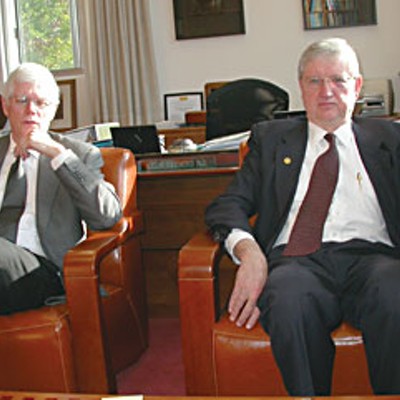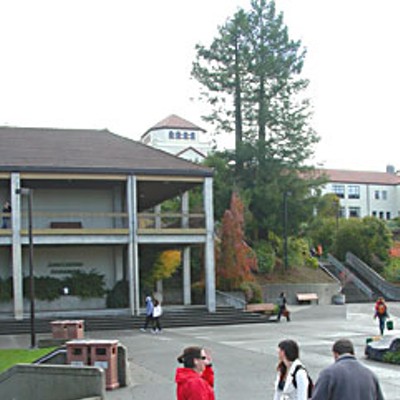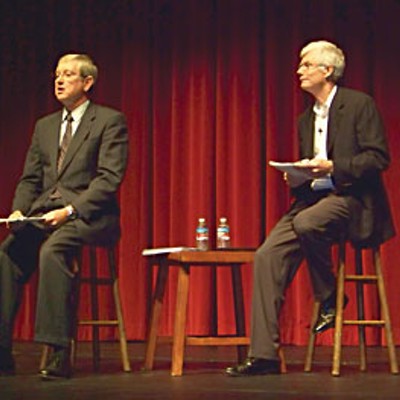Humboldt State University is in trouble -- serious trouble, though you wouldn't know it to walk around the campus. Students still happily yak on cell phones in the quad, hike up and down the Founders Hall stairs and file into the environmentally cutting-edge new Behavioral and Social Sciences building.
No, the trouble lies deeper than that. It's intangible yet systemic, and according to outside experts who have investigated HSU at length, this trouble should not -- must not -- be ignored. As the pool of higher education funding drains away, fundamental problems submerged in the culture and operations of HSU have come to the surface.
There's an atmosphere of distrust and animosity on campus, administrative systems fraught with inefficiencies, and finances that have been eroded to the bedrock. HSU is now on the verge of losing its status as a sanctioned institute for higher learning. After closely examining the school, a series of inspectors and consultants have delivered a unanimous message: Change now or you won't survive.
The first serious alarm was sounded in February with a report from the Western Association of Schools and Colleges (WASC), HSU's regional accrediting organization. Citing ineffective curricular oversight and labyrinthine processes for budgeting and decision-making, the agency elected to delay its Educational Effectiveness Review -- essentially a pass/fail inspection to determine whether the school is up to California State University standards -- by a year, from Spring 2009 to Spring 2010.
Following WASC recommendations, HSU President Rollin Richmond called for help. The university employed the services of Keeling & Associates, a respected higher-ed consulting firm based in New York City. Over several weeks, the Keeling consultants reviewed data on the university's history and operations, conducted phone interviews with staff, faculty and administrators, and finally, in mid-September, a team of consultants visited the campus for a closer look.
On Oct. 7, Keeling & Associates issued its 31-page report -- a scathing appraisal of a college in almost complete disarray. President Richmond's leadership was described as "ineffective," as were the university's decision-making processes. The "dysfunctional" campus culture has created "a fatigued if not demoralized administration, faculty, staff, and student body." The school lacks a shared vision, the report stated, a common purpose among university leaders.
That wasn't the worst of it. In their interviews, the consultants encountered deep-seated suspicion of leadership, a near-total lack of confidence in administrative intentions, and, perhaps worst of all, they said solutions are unlikely to emerge from the university as it is currently organized. "[T]he loss of trust at Humboldt is so profound," the report stated, "that it cannot be overcome without significant institutional change."
WASC's decision to postpone the accreditation review was not merely an institutional favor but "a clear signal of problems of crisis-level proportions." Should the school lose accreditation, its federal financial aid would be cut and the subsequent damage to its admissions and reputation would be immense. In short, Keeling & Associates concluded that HSU is in the midst of "a legitimate institutional emergency."
While the report's near-apocalyptic tone shocked many on campus, few disagreed with its conclusions. "I think we all read it and said, 'Yeah, we've been saying that,'" said Val Arizzi, an administrative support coordinator in the geology department and co-chair of HSU's staff council. "I don't know if the administration and the president were surprised, but the staff wasn't surprised."
The Keeling people spread blame in many directions, but ultimately, they said, the responsibility lies with the captain of this listing ship -- President Richmond. Speaking with the Journal from his office on the second floor of Siemen's Hall, Richmond -- who was joined by interim Provost and President of Academic Affairs Bob Snyder -- addressed the immense challenges facing the university.
A man of resolute intellectualism with a background in evolutionary biology, Richmond views this crisis from a scholarly, scientific remove. In the middle of a long and seemingly painful chronicle of the school's communication issues, Richmond took a rhetorical step back. Human beings, he explained, have evolved to prioritize one imperative above all others -- passing our genes on to the next generation.
"That's why we design political systems and social systems," Richmond said, "to try to balance that innate biological directive with the needs of multiple people living together." Those systems don't eliminate the self-preservation instinct, he said; they merely raise the stakes from individuals to groups. What you're left with, Richmond explained, is tribalism -- "one tribe saying, 'This is my territory, you can't have anything to do with it and I'll support the people who support me and to hell with the other tribe over there.'"
That's the current state of HSU: The administrators, faculty, staff and even students have been reduced to warring tribes, fighting over the scraps of a decimated education budget while the future of this 95-year-old university hangs in the balance.
How did Humboldt get to this point? The Keeling report identifies numerous culprits, including poor communication, an overly complex administration, a lack of strategic (as opposed to seat-of-the-pants) decision-making and a general absence of community on campus.
Richmond, not surprisingly, found the analysis to be needlessly brutal. After posting the report on-line, he sent a response to Keeling & Associates requesting that they soften some of the harshest recriminations, which they did. Richmond posted this revised version on the Web days later, saying in an e-mail to faculty, staff and students that the first version had merely been a preliminary draft, posted by mistake. (An e-mail following the first posting made no reference to it as a draft.) Richmond left both versions on-line.
Like any good psychiatrist, the Keeling consultants cautioned that before any substantive changes could be made, university leaders must first admit that problems exist. With evident frustration, Richmond told the Journal that, yes, the university is in crisis. But it's the state, he said, not the university that's responsible.
"When I was an undergraduate at San Diego State about 40 years ago, California was in the top 10 states in the nation in per capita spending for education across the board -- from kindergarten through higher education," Richmond said. "We are now 46th and falling." Richmond feels that from as far back as Prop. 13, the 1978 initiative that capped property taxes, California has been steadily abandoning its commitment to education.
The current state budget crisis may have the most devastating effects yet on the 23-campus CSU system, the largest university system in the nation. When the state legislature finally passed a budget in August following a long and quarrelsome standoff, Gov. Arnold Schwarzenegger asked for budget cuts, including $31.3 million from the CSU budget. CSU Chancellor Charles Reed acquiesced (HSU's share was $849,000) despite having recently raised student admission fees, a move that angered many union members.
"[Chancellor Reed] can't increase fees and then turn around and say to the governor, 'We really don't need this money,'" said Robin Meiggs, chair of HSU's chapter of the California Faculty Association.
Two weeks ago, Gov. Schwarzenegger asked the legislature to approve more cuts -- including another $66.3 million from the CSU budget -- to help close the state's estimated $11.2 billion shortfall. HSU's share, should this request be approved, would be $1,796,700, bringing its total cuts this academic year to nearly $2.65 million. According to Reed, CSU's budget was already $215 million below the system's operational needs.
"We've been down to the bone for years," said HSU spokesman Paul Mann. "Now we're down to the marrow."
Arizzi said her operational expenses have been cut by 25 percent in the last five years. The geology department's copy machine is old, she said, but there's no money to replace it. Two people now often do the work of three. Earlier this year, the department was forced to lay off a promising lecturer.
While Richmond has assured everyone that HSU budgeted conservatively enough to cover these cuts (assuming they're not made permanent) the school will soon likely be forced to follow others in the CSU system in laying off more lecturers, eliminating classes -- if not entire departments -- and increasing class sizes. In a meeting with the CSU's board of trustees in Long Beach this week, Chancellor Reed was expected to announce that for the first time in its history, CSU will likely not be able to accept all eligible students into next year's freshmen class.
This steady plunder of education coffers has left Richmond at the end of his rope. "What frustrates me so much is that the people of the state of California, as represented by their legislators, do not recognize the value of what we've got here," he said, his voice rising. "They do not recognize that there's a causal relationship between the economy of California and how much they invest in education." Pointing out that the state's prison budget may soon exceed its investment in higher education, Richmond grew angry and, pounding the arms of his chair, he demanded, "What is the matter with the people in this state?"
Richmond is not the only one who's upset. The cuts have exacerbated already caustic relations between the factions at HSU. While Richmond's appointment as president in 2002 was widely hailed as a step toward clearer communication and greater inclusiveness (he arrived on the heels of the maligned presidency of Alistair McCrone), the intervening years have seen growing divisions between administration, faculty and staff.
This divide actually has an architectural manifestation in those mission-style entrance gates and kiosks erected hastily in the summer of 2005. Designed to be decorative symbols delineating campus borders and, it was hoped, boosting admission, the gates instead came to represent the president's perceived sense of sovereignty (though there was, in fact, a jump in admissions following their construction).
"[The staff] had no prior knowledge of those gates," Arizzi said. This type of poor communication is rampant, she explained, and is "one of the cruxes of the mistrust" on campus. "There's a sense that administrators do whatever they want to do."
Richmond's faculty relations have not been any better. Dr. Saeed Mortazavi chairs the Academic Senate, a faculty body that makes policy recommendations to the president. He feels that Richmond has shown little respect for the faculty and has unfairly reduced its role in decision making, especially on budgetary matters.
Several years ago, HSU set out to reform its budgeting process, which had grown cumbersome and ineffective. Mortazavi was deeply involved in the reforms, co-chairing a committee tasked with developing a new policy. What emerged was the University Budget Committee, a fiscal decision-making body co-chaired by the provost and the chair of the Academic Senate. The majority of its members came from faculty.
Mortazavi and other faculty members were pleased with the result but said the administration criticized the UBC's makeup from day one. Twice Richmond changed the group's lineup and, per his revisions, the UBC now has just 10 voting members, of which four are faculty. And the president has final say on any decisions.
Mortazavi feels the current setup has reversed the budgeting process from being bottom-up governance to top-down, with faculty just there to offer a stamp of approval. "At this time, the faculty has lost its voice in the UBC, or at least doesn't have the majority," Mortazavi said. "The UBC -- the way it exists today -- is not going to be as effective as it was."
Richmond says Mortazavi is mischaracterizing the process. It's more efficient now, he said, and more effective. Voting members in the old setup focused disproportionately on their own needs, Richmond feels, rather than those of the university. "It took a long time and resulted in relatively little useful information," he said.
Regardless of the system, the Keeling report griped that "conversations about budget, especially, seem never to end."
Tensions with faculty aren't limited to the budgetary matters. According to the Keeling report, the faculty harbors an acute distrust of central authority and a resistance to academic standardization and assessment.
Richmond has encountered this resistance in his repeated attempts to push the faculty toward further academic scholarship and research. "This is an important component to [the faculty's] responsibility to the university, to the people of the state of California which support this institution and to the students," Richmond said.
But faculty members have questioned his priorities, insisting that student instruction should remain their primary focus. Some also have questioned his motives, suggesting that the CSU Chancellor's office pushes research as a way to land grant money, a charge Richmond denies.
The president, in turn, lays the blame for Humboldt's contentious atmosphere primarily at the feet of the CSU's unionized system. "That always puts a table between people," he said. "It's been a very combative relationship, and I think that's done damage to the university as a whole."
His battle with the faculty union reached a crescendo late last year. Members of the Academic Senate felt that Richmond was ignoring their concerns and had become unapproachable. He was trying to run HSU like a business, they said, and the administration's cuts, particularly their elimination of the German major, were interpreted as a sign that Richmond cares little for the needs of students.
In an October 2007 survey -- albeit a flawed one by most accounts -- 156 of 408 voting Academic Senate members called for a vote of no confidence in the president. This past May, just as parents were arriving for graduation, a group of 160 past and present faculty members took out full-page ads in both the university paper and this one featuring a petition, signed by each of them, "affirming no confidence in President Rollin C. Richmond."
It was a bold challenge, though it ultimately didn't amount to much. As the budget crisis began to take precedence, the efforts to censure Richmond were reluctantly abandoned. According to Mortazavi, the Academic Senate decided the gesture wouldn't be productive for the university. (In a separate but related issue, the 23,000 members of the California Faculty Association CSU-wide considered a strike over a contract dispute. That, too, was narrowly avoided.)
Students and staff have had beefs with Richmond as well. The Associated Students didn't like the elimination of German either, and a 2006 increase in athletic fees -- which went against the recommendation of both the Fee Advisory Committee and Associated Students -- prompted AS to censure the president in April 2007 and to consider its own no confidence vote. The official censure document matter-of-factly referenced the president's "past and present failed leadership."
Jerry Saner, president of Humboldt's chapter of the California State University Employee's Union (CSUEU) said Richmond's contempt for unions is unjustified. The system levels the playing field and guards against favoritism, he said, adding that by suggesting otherwise, Richmond was being disrespectful. "We've been conscientious to do our part to communicate," Saner said.
The Keeling report repeatedly suggests that the problems at HSU lie not with the unions or even the budget, but with a failure to approach problems strategically. Crises at the university tend to be dealt with "tactically," the report said. In other words, when fires flare up they're extinguished one at a time rather than through comprehensive solutions -- like, say, a sprinkler system.
This is not necessarily for lack of effort. Shortly after Richmond's 2002 arrival at HSU, he and the rest of the administration began an extensive strategic planning process, despite the president's general leeriness of such plans. In his experience, he said, it's a lot of time and energy invested in something that ends up sitting on a shelf. But they persevered, coming up with a document that Richmond felt accurately described "the essence" of the university.
"No sooner was it put in print than it was put on a shelf and nothing was done with it," said Meiggs, who sat on the steering committee during the planning process. The plan may have described the essence of Humboldt, but it was sorely lacking in specifics.
When asked how many of HSU's troubles are his fault, Richmond acknowledged that as president, he carries ultimate responsibility. He pointed to this planning process as something he wishes he'd done differently. "I regret that I didn't focus more on making decisions from a strategic perspective" he said.
As to whether or not the faculty has been disrespected, interim Provost Snyder stepped in. "The curriculum is the purview of the faculty," he said testily, implying that such matters as budgetary decisions are not their purview, or at least not theirs exclusively. Then, seeming to recognize that he'd slipped back into battle mode, Snyder paused and sighed deeply. "For me," he said, "this [fight] is just symptomatic of the problem we have here, which is the inability to trust and work together cooperatively."
On Friday afternoon, Richmond and Snyder took the stage in HSU's Van Duzer Theatre. Bathed in a double spotlight, the men leaned awkwardly against their stools at center-stage. It looked like the setup for a magic act, but the mood in the theater was pensive. The sizable crowd of faculty, staff and students had come for answers.
Richmond had arranged this forum to review the WASC and Keeling reports and to explain what was being done in response. As most on campus were already aware, Snyder was in the midst of an academic prioritization process in which each department on campus was instructed to analyze its programs and grade them in terms of importance, the idea being to eliminate what's not working.
The Keeling consultants felt that this effort, which began last year, should by all means continue. The process is going as planned, Snyder assured the crowd, and should be sorted out by the end of the academic year.
Richmond then launched into a discussion of the Keeling report. Holding a stapled stack of notes in his lap, he glossed over the indictments and moved quickly on to what is being done. At Keeling's suggestion he formed an Expanded Executive Committee, with representatives from nearly every branch of HSU, to consider three questions:
Should we act upon the Keeling report recommendations?
Do we need help from consultants?
What process should we use to reach decisions regarding the recommendations contained in the WASC and Keeling reports?
In three meetings held the previous week, the Expanded Executive Committee had answered "yes" to numbers one and two, though not without reservations. Number three, Richmond said, remains only partially answered. If the quantity of bullet points are any indication, the plan thus far looks decidedly strategic.
Keeling & Associates will return to campus to help HSU through a four-stage plan addressing the 14 recommendations laid out in their report. Among those recommendations: The president should publicly admit the gravity of the situation; he should appoint Snyder as the permanent provost; the university should suspend all non-essential governance activities; and Richmond should appoint a Cabinet for Institutional Change to be made up of faculty, staff, administrators and students.
Aside from the suggestion to make Snyder permanent provost (Richmond approved but the faculty senate was split), the Keeling recommendations have been accepted and progress, cumbersome though it may be, has begun. A budget consultant has laid out suggestions for a transparent budgeting process free of gamesmanship. Through the academic prioritization process, individual departments have now been examined more thoroughly than they had in years. And thanks to Keeling's kick in the institutional pants, university leaders are reportedly working toward a system of shared governance that is truly inclusive.
Addressing the crowd, Richmond made a point of clarifying, as he did in his meeting with the Journal, that the myriad problems confronting HSU do not necessarily reflect upon the quality of education on campus. "Humboldt State is a good university," he said somewhat defiantly. "It has been good for a long time."
Indeed, while the Keeling report is brutally frank in its critique of HSU, the analysis is not without bright spots -- even a few compliments. The consultants found "strong institutional assets" including a campus community that maintains a "readily perceptible, genuine hope and hunger for renewal." The challenge, they said, will be mobilizing those good intentions.
During the question-and-answer period following Friday's presentation, HSU's salvation seemed feasible. Here was a gathering of staff, faculty and students communicating with one another, apparently focused on a common goal. Jerry Saner, dressed in his blue workman's coveralls, took hold of the microphone being passed around and asked Richmond and Snyder, "What can we do to help?"
Meiggs, for one, said there's no doubt in her mind that HSU will be re-accredited next year. "I work up here every day, and I see the work being done," she said. She recently met with Richmond to discuss his dislike of unions and emerged from the meeting feeling "very optimistic" about the future.
But the layers of distrust at Humboldt State have been accumulating for years, and undoing the damage won't come easy. An HSU lecturer, speaking on condition of anonymity for fear of losing her job, told the Journal that things are hardly as civil as Friday's meeting may have suggested. In fact, she called the entire display "absolute rubbish" and suggested that many people in attendance remain "pissed off" at Richmond but are reluctant to voice their opinions lest they be deemed non-essential.
Whether HSU will be able to heal this culture of fear and distrust remains to be seen. What's clear is that more people than ever are paying attention to the problems on campus, and that, in and of itself, may be an important step.
"One of the things the Keeling report ... has done is to get people's attention," Richmond said. "If they've done nothing else, they've created a sense of urgency. This is an opportunity which you don't have when things are going well. It's an opportunity to make change that may not occur again for a long time."






Comments (5)
Showing 1-5 of 5